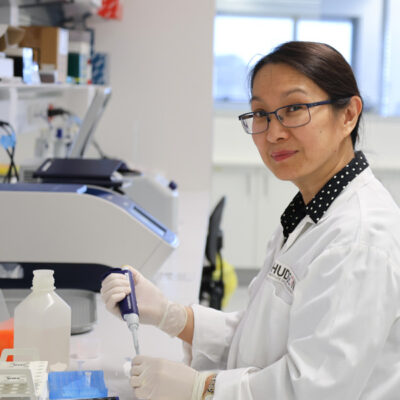Evelyn’s story | infiltrating bowel endometriosis
By Hudson Institute communications

‘Invisible illness’ took years of pain and a trip to the emergency ward before an endometriosis diagnosis.
It wasn’t until Evelyn’s debilitating symptoms started to impact her daily life that she sought help – but that was only the beginning of her endometriosis journey.
“It all came to a tipping point in 2016, when my menstrual cycle was impacting my whole life, with horrible pain, fatigue and dizziness that left me bed-ridden and barely able to walk,” Evelyn said.
Evelyn saw several doctors who she says either prescribed a supplement to help with her menstrual cycle, attributed the pain to inflammation due to a virus, or didn’t investigate further.
The 34-year-old communications professional says that advocating for her own health was instrumental. “I had to advocate for myself to get a diagnosis and trust my own body to know what was right and what wasn’t,” she said.
After a presentation at the emergency department, Evelyn had a transvaginal scan that led to a diagnosis of deep infiltrating bowel endometriosis. Deep infiltrating endometriosis is a form of endometriosis where tissue that normally lines the uterus is not only found outside of the womb – it also spreads through the lining of the pelvis or other tissues to infiltrate ligaments, the bowel or bladder.
Doctors told Evelyn that, based on the severity of her symptoms, the disease had most likely been present in her body for 10 to 15 years. There is no early diagnostic test that tests for all types of endometriosis.
Evelyn is grateful for the care she has received from top endometriosis experts in Melbourne, and the support from “my wonderful husband who accompanied me to every appointment, scan and support group meeting”.
“When I was initially diagnosed, I felt overwhelmed, but having the support of my medical team and reaching out to other women with endometriosis has made me very hopeful that I can manage the disease, have a full life and not be defined by it,” she said.
Evelyn says one of the most challenging things about having endometriosis is speaking out about this ‘invisible illness’. “Having an invisible illness that deals with the topic of menstruation makes it difficult, at times, to express to other people what you are going through. Just because you ‘look’ well, doesn’t mean you are feeling well,” she said.
She is hopeful that treatment and diagnosis for endometriosis will improve in her lifetime. “For a condition that affects 1 in 10 women worldwide, I believe there should be a greater urgency in the funding sectors to make endometriosis a curable disease and to make women’s health a top priority.”
About Hudson Institute
Hudson Institute’ s research programs deliver in three areas of medical need – inflammation, cancer, women’s and newborn health. More
Hudson News
Get the inside view on discoveries and patient stories
“Thank you Hudson Institute researchers. Your work brings such hope to all women with ovarian cancer knowing that potentially women in the future won't have to go through what we have!”




